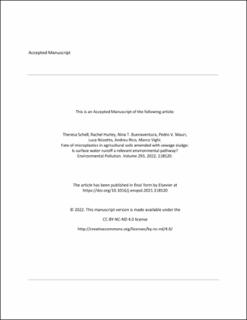Fate of microplastics in agricultural soils amended with sewage sludge: Is surface water runoff a relevant environmental pathway?
Schell, Theresa; Hurley, Rachel; Buenaventura, Nina Tuscano; Mauri, Pedro V.; Nizzetto, Luca; Rico, Andreu; Vighi, Marco
Peer reviewed, Journal article
Published version

View/
Date
2022Metadata
Show full item recordCollections
- Publikasjoner fra Cristin - NIVA [2160]
- Scientific publications [1172]
Abstract
Sewage sludge used as agricultural fertilizer has been identified as an important source of microplastics (MPs) to the environment. However, the fate of MPs added to agricultural soils is largely unknown. This study investigated the fate of MPs in agricultural soils amended with sewage sludge and the role of surface water runoff as a mechanism driving their transfer to aquatic ecosystems. This was assessed using three experimental plots located in a semi-arid area of Central Spain, which were planted with barley. The experimental plots received the following treatments: (1) control or no sludge application; (2) historical sludge application, five years prior to the experiment; and (3) sludge application at the beginning of the experiment. MPs were analyzed in surface water runoff and in different soil layers to investigate transport and infiltration for one year. The sewage sludge used in our experiment contained 5972–7771 MPs/kg dw. Based on this, we estimated that about 16,000 MPs were added to the agricultural plot amended with sludge. As expected, the sludge application significantly increased the MP concentration in soils. The control plot contained low MP concentrations (31–120 MPs kg−1 dw), potentially originating from atmospheric deposition. The plot treated five years prior to the experiment contained 226–412 and 177–235 MPs kg−1 dw at the start and end of the experiment, respectively; while the recently treated plot contained 182–231 and 138–288 MPs kg−1 dw. Our study shows that MP concentrations remain relatively constant in agricultural soils and that the MP infiltration capacity is very low. Surface water runoff had a negligible influence on the export of MPs from agricultural soils, mobilizing only 0.2–0.4% of the MPs added with sludge. We conclude that, in semi-arid regions, agricultural soils can be considered as long-term accumulators of MPs.
Description
Embargo until November 18, 2023
